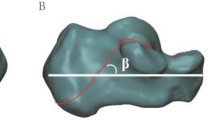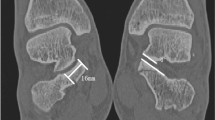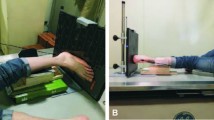Abstract.
The aim of this study was the evaluation of spiral-CT examinations in preoperative planning of calcaneal fractures supported by 3D reconstructions after electronic disarticulation. We examined 45 patients with 47 calcaneal fractures with diagnostic spiral-CT examinations in a prospective study. In addition to the conventional axial slices and sagittal reconstructions, 3D reconstructions prior to and after electronic disarticulation were performed and rated by orthopaedic surgeons and radiologists. The following diagnostic criteria were rated: involvement of articular facets, number of fragments and hindfoot deformities. Axial slices were considered to be the gold standard, because not all patients underwent surgical treatment. Axial slices showed involvement of 90 articular facets (100 %). Three-dimensional reformations after electronic disarticulation depicted 82 fractures (82 of 90, 91 %), sagittal reconstructions 63 fractures (63 of 90, 70 %). Three-dimensional reconstructions without electronic disarticulation showed five fractures (5 of 90, 5.5 %). The number of fragments was demonstrated best on sagittal reconstructions (two, three or four fragments); five fragments were diagnosed best on axial slices, and 3D reconstruction without electronic disarticulation showed only a very small number of fragments, due to overlaying bones. Hindfoot deformities (lateralisation, varus deformation, shortening) were demonstrated best on axial slices, except in terms of showing height reduction, which was demonstrated better on sagittal and 3D reconstructions. Three-dimensional reconstructions after electronic disarticulation support a clear understanding of the 3D position of the fragments and of their displacement in comparison with 3D reconstruction without electronic disarticulation, which is essential for an effective surgical reduction. Due to the potential manipulation of surface-oriented 3D reconstructions, regardless of whether electronic disarticulation is used, this imaging technique should not be considered in an isolated framework. Three-dimensional images without electronic disarticulation are superfluous in any case.
Similar content being viewed by others
Author information
Authors and Affiliations
Additional information
Received: 1 April 1998; Revision received: 2 July 1998; Accepted: 24 September 1998
Rights and permissions
About this article
Cite this article
Freund, M., Thomsen, M., Hohendorf, B. et al. Optimized preoperative planning of calcaneal fractures using spiral computed tomography. Eur Radiol 9, 901–906 (1999). https://doi.org/10.1007/s003300050764
Issue Date:
DOI: https://doi.org/10.1007/s003300050764




